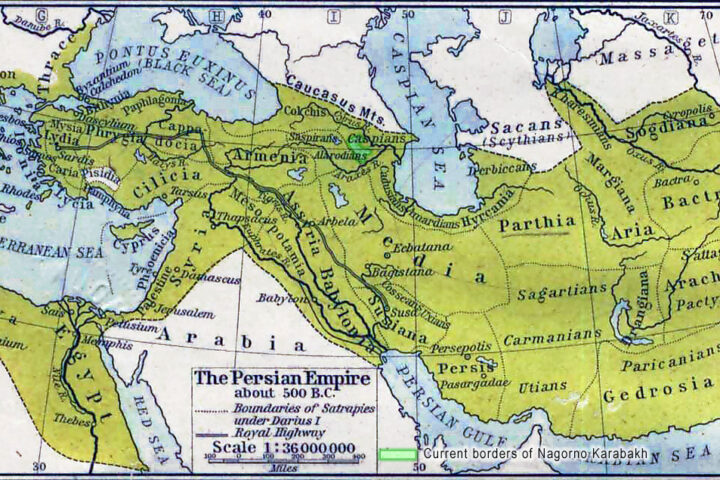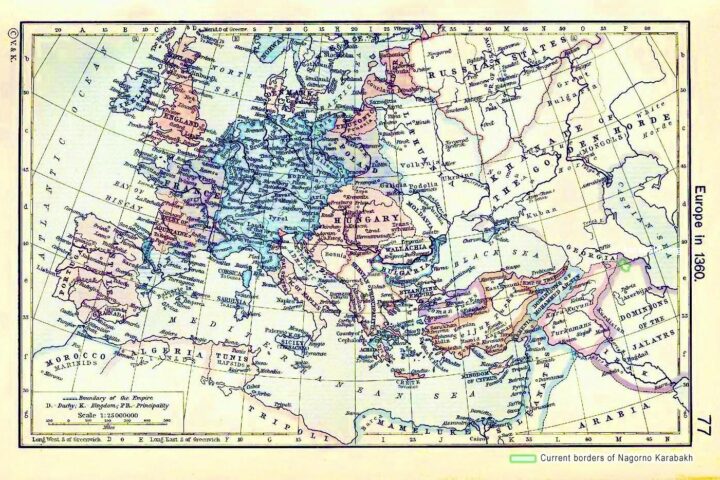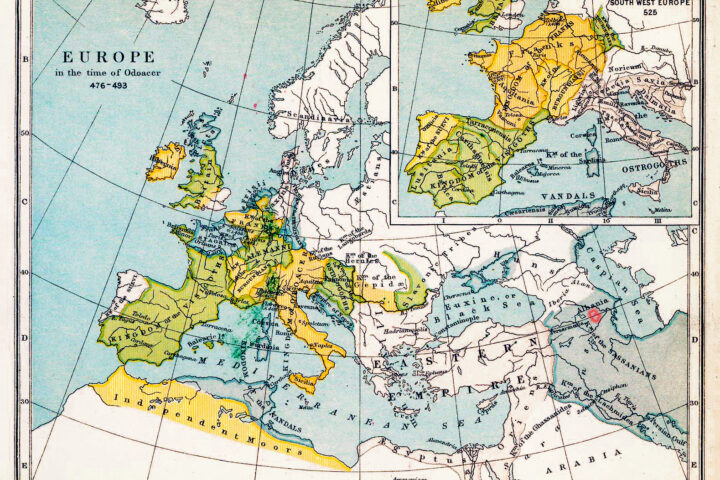— Why is it that the Kavburo of the Central Committee of the RKP(b) wanted to resolve the Karabakh question “in complete secrecy”?
Moscow and delimitation of Karabakh in the 1920’s
The establishment of Soviet power in Armenia on November 29, 1920, created suitable conditions for the communists to again put the Karabakh problem forward for discussion. In connection with the proclamation of Soviet power in Armenia, Nariman Narimanov, the president of the Azerbaijan Revolutionary Committee, and Mirza Davud Huseynov, the Peoples Commissar of Foreign Affairs, sent on November 30, a telegram of greeting to the Armenian Revolutionary Committee. There was a serious difference between the text of this telegram and the decision of the joint session of the Politburo and Orgburo of the Central Committee of the AKP(b). A whole list of contradictory moments were contained also between the well-known speech of N. Narimanov at the celebratory session of the Baku Soviet on the occasion of the establishment of Soviet power in Armenia and the declaration read out by him on December 1, 1920.
The declaration read that “Soviet Azerbaijan, in support of the struggle of the fraternal Armenian toiling people against the power of the Dashnaks which have shed and continue to shed the innocent blood of our best comrade communists in the borders of Armenia and Zangazur declares that from now on, no territorial issues can become the course of mutual bloodletting of the two neighboring peoples, the Armenians and the Muslims, that the territory of the Zangazur and Nakhchivan districts are an indivisible part of Soviet Armenia, that the toiling peasantry of Nagorno-Karabakh is given the complete right of self-determination, and that all military actions in the borders of Zangazur are to be stopped and the forces of Soviet Azerbaijan withdrawn.” [1]
It should be immediately noted that the text of the December 1 declaration contradicts the decisions taken by the Central Committee of the AKP(b) of November 4 and November 30. At the session of November 4, when the corresponding paragraph of a draft Russian-Armenian Treaty was discussed in the presence of I. Stalin and G. Ordzhonikidze, it was decided that “the paragraph with the proposal about the transfer of Nakhchivan and Zangazur to Armenia is not profitable either from a political or from a strategic perspective.” However, in contradiction to this decision, in connection with the victory of Soviet power in Armenia, a decision was taken at a the November 30 session of the Central Committee of the AKP(b) to transfer Zangazur to Armenia, but there was no mention of Nakhchivan. This is why B.V. Legran on December 2 of the three designated territories speaks only about the inclusion of Zangazur within the borders of Armenia as a fact recognized by Soviet Russia. [2]
But in the Declaration read out by N. Narimanov on December 1, along with Zangazur is also mentioned Nakhchivan as territories handed over to Armenia. Iorg Baberovsky, a professor of Humboldt University, asserts that already in the summer of 1920, under pressure from Ordzhonikidze, Narimanov was forced to promise to concede Zangazur, Karabakh and Nakhchivan to Armenia (Baberovski 2010, p. 237).
The text of the Declaration published in the Baku media was distorted by Ordzhonikidze even before it reached the press. On December 1, in a code cable to B. Legran and G. Chicherin, he wrote that “Azerbaijan has already conceded and transferred to Soviet Armenia Nakhchivan, Zangazur and Nagorno-Karabakh.” [3] He sent a similar report on December 2 to V.I. Lenin and I.V. Stalin. In that message, he said, “Azerbaijan yesterday already declared in favor of transferring to Soviet Armenia Nakhchivan, Zangazur and Nagorno-Karabakh.” [4]
On December 4, this “happy” news on the initiative of I. Stalin was published in Pravda, and on the basis of the distorted telegram of G. Ordzhonikidze on the same day on the pages of this same paper was published an article of I. Stalin in connection with the proclamation of Soviet power in Armenia. Then, that article passed into the fourth volume of the collected works of I. Stalin, which remains often cited to this day. The question arises: Was G. Ordzhonikidze fully informed or did he intentionally make this error?
After the establishment of Soviet power in Dilizhan, G. Ordzhonikidze had a conversation by direct line with Amayak Nazaretyan, in which, referring to the Declaration of N. Narimanov, he said, “Today in Baku was a celebratory meeting of the Soviet at which Narimanov read the Declaration of the Azerbaijani government indicating that borders between Soviet Armenia and Azerbaijan no longer exist, that from today, the territory of the Zangazur and Nakhchivan districts have become an indivisible part of Soviet Armenia and that the Armenians of Nagorno-Karabakh are offered the right of self-determination. The wealth of Azerbaijan, oil and kerosene, are the common property of both union republics.” Delighted by this, A.M. Nazaretyan exclaimed “Bravo, Azerbaijanis!” [5]
This is how the December 1 Declaration of N. Narimanov, the president of the Azerbaijan Revolutionary Committee, underwent an “easy” correction by the Bolsheviks. In the Baku newspapers, Kommunist on December 2 and Bakinsky rabochy on December 3, there was reference to offering the toiling peasantry of Nagorno-Karabakh “the right to self-determination,” but in the Kommunist published in Armenia on December 7 there was reference to “the recognition of Nagorno-Karabakh as a constituent part of the Armenian Socialist Republic.”
Such a crude falsification of the text of the Declaration infuriated N. Narimanov. In the course of a discussion of the Karabakh question at the session of the Kavburo of the Central Committee of the RKP(b), he assigned M.D. Huseynov, the peoples commissar of international affairs, who was in Tiflis in June 1921 to inform the Caucasus Bureau of his opinion about Nagorno-Karabakh. [6]
Thus, the question arises: did anyone in Armenia and in Russia see the true text of the Declaration? In addition to the notes and correspondence of G. Ordzhonikidze, there was also a telegram with the text of the Declaration sent to the Armenian Revolutionary Committee over the signatures of N. Narimanov and M.D. Huseynov. Precisely on the basis of this document, Askanaz Mravyan, a member of the Armenian Revolutionary Committee, reported to Saak Ter-Gabrielyan, the Armenian representative in Moscow, that Azerbaijan had declared about the unification [with Armenia] of Zangazur and Nakhchivan and about a referendum in Nagorno-Karabakh. [7] And even later, in the collection of documents published in Yerevan in 1957 entitled The Great October Socialist Revolution and the Victory of Soviet Power in Armenia was published the correct text of the December 1 declaration as preserved in the Central State Archive of Armenia. [8]
Despite all this, from the mid-1980s, Armenian authors, and recently Russian political scientists as well, have preferred to refer not to the original of the text, but to its “corrected” version. Unfortunately, this operation with documents about Karabakh is not the first and not the last such case.
Why is it that the idea of transferring Zangazur to Armenia was mentioned in N. Narimanov’s Declaration at all? In fact, this idea came from Moscow, from the Politburo of the Central Committee of the RKP(b). The initiator of this declaration was G. Ordzhonikidze. And why did G. Ordzhonikidze, who before this had recognized the attachment of Zangazur to Azerbaijan, suddenly change his convictions? The answer is that by means of transferring Zangazur to Armenia, he wanted to drive a wedge between Azerbaijan and Turkey, which in the future would reduce the threat from Turkey to Azerbaijan. While travelling from Baku to Moscow, I. Stalin on November 23, 1920, from Rostov-na-Donu by direct line reported to Lenin that according to Ordzhonikidze, at that moment the basic danger consisted in the striving of the Turks to have a common border with Azerbaijan. In connection with this, Ordzhonikidze proposed to block the intentions of the Turks by means of the transfer of Zangazur to Armenia. [9] Therefore, the Turks considered the treaty between Soviet Russia and Dashnak Armenia and also friendly relations between these countries after the Sovietization of the latter as an obstacle on the path of Turkey to the Muslim peoples of the Caucasus. [10]
However, already on November 4, 1920, during the well-known trip of I. Stalin to the Caucasus, a joint session of the Central Committee of the AKP)(b) and the Kavburo of the Central Committee of the RKP(b) took place, at which the report of B. Legran on the situation in Armenia was heard and a corresponding resolution adopted. Point B of this document, which concerned the treaty under discussion between Russia and Armenia, noted, “at the same time, to communicate to the Politburo that the point proposed in the treaty about the transfer to Armenia of Nakhchivan and Zangazur [which Moscow had proposed] is unsuitable politically and strategically and can be carried out only in an extreme case.” In point G, N. Narimanov was assigned the task of composing the opinion of the Politburo about Nakhchivan and Zangazur. [11]
As we see, at this time, the Nagorno-Karabakh problem in general did not exist and therefore it was not discussed. On November 20, 1920, the diplomatic mission of Soviet Russia arrived in Yerevan. One of the first steps of the mission was the tracking of the course of negotiations between Turkey and Armenia in Gyumri, as well as investigating the territorial claims of Armenia against Azerbaijan and Georgia. G. Chicherin, the peoples commissar of foreign affairs of the RSFSR, received a report that “now, the existence of the Armenian people depends not so much on military force as on diplomacy. It is necessary to avoid party romanticism and arm oneself with tough realism.” As concerns Armenian claims to Karabakh, the diplomatic mission reminded Chicherin: “In Batumi, Kachaznuni and Khatisan, while conducting talks with the Turks [this refers to the peace conference in Batumi in May-June 1918], agreed to give Karabakh to Azerbaijan.” [12]
Despite the declaration of N. Narimanov on December 1, Nakhchivan and also Karabakh with both its lowland and mountainous parts continued to be left within Azerbaijan. However, after the signing of the Moscow treaty between Soviet Russia and Kemalist Turkey on March 16, 1921, according to which the Nakhchivan oblast was formed as an autonomous territory under the protectorate of Azerbaijan with the condition that Azerbaijan would not yield its protectorate to a third state, the question relative to the mountainous part of Karabakh was again advanced to the first place in the order of the day in the relations of Azerbaijan and Armenia.
On June 3, 1921 a session of the Caucasus Bureau of the Central Committee of the RKP(b) took place with the participation of Ordzhonikidze, Makharadze, Narimanov, Myasnikov, Orakhelashvili, Nazaretyan, Figatner, as well as a secretary of the Azerbaijan KP(b) Kaminsky and a member of the Central Committee of the KP(b) of Georgia Eliava. At its evening session, three questions were discussed: 1. The Azerbaijan question; 2. The Zangazur question; and 3. Concerning nomads. The decisions on the first and third questions are reflected in protocol Number 6; but concerning the second question, in place of a decision there is the note “see the attachment to the protocol.” [13] Here, as they say, is the root of the evil.
First of all, the decision of the Kavburo of the Central committee of the RKP(b) on the Zangazur question, which consists of seven points, was adopted with the mark “top secret,” although protocol number 6 as a whole does not have this classification. Second, of the seven points of this secret decision, only six concern Zangazur and point five is exclusively about Nagorno-Karabakh. The latter reads as follows: “to note in the declaration of the Armenian government that Nagorno-Karabakh belongs to Armenia.” [14] That is, in a “top secret” form, Armenia was directed to issue a government declaration, where it would specify that Nagorno-Karabakh belongs to Armenia.
Following such a decision, on June 12, the Soviet of Peoples Commissars of Armenia published a decree about joining the mountainous part of Karabakh to Armenia. It said that “on the basis of the declaration of the Revolutionary Committee of the Socialist Soviet Republic of Azerbaijan and agreement between the socialist republics of Armenia and Azerbaijan it is proclaimed that from now on Nagorno-Karabakh is an inalienable part of the Socialist Republic of Armenia.” [15] This decree signed on June 12 by A. Myasnikov (Martuni) and M. Karabekyan was discussed in the Central Committee of the KP(b) of Armenia on June 14, after which a decision was taken about its publication. There it was stated: “To publish the decree about the unification of Nagorno-Karabakh to Soviet Armenia.” At this same session, the fifth point of order was the question “about the direction of a representative to Karabakh.” In the decision it was written: “Comrade Mravyan together with Pirumov, Akop Ioanisyan, Ter-Simonyan and a group of other comrades are to be sent to Karabakh. [16] In correspondence with this decision, only on June 19, that is after a whole week had gone by, the Armenian Revolutionary Committee published in the press the government degree. Askanaz Mravyan was confirmed as the extraordinary plenipotentiary to Nagorno-Karabakh.
An examination of the text of the June 12 decree of the Sovnarkom of Armenia reveals some interesting moments: In spite of what was written in the decree, neither in the declaration of the Azerbaijan Revolutionary Committee was anything said about the transfer of Nagorno-Karabakh to Armenia, nor between the republics was there formed any juridically significant agreement. Apparently, the authors of the decree were inspired by the “top secret” decision on the “Zangazur question,” adopted by the Kavburo of the Central Committee of the RKP(b) under the chairmanship of G. Ordzhonikidze and the secretaryship of Y. Figatner of June 3, 1921. And somehow, the decision of the Kavburo of the Central Committee of the RKP(b) is not mentioned in the June 12 decree. Apparently, first of all, the “top secret” stamp prevented such a reference, and second, the Kavburo of the Central Committee of the RKP(b) did not have the power to take such a decision.
References
Baberovsky, Iorg (2010) The Enemy is Everywhere: Stalinism in the Caucasus (Vrag Yest Vezde: Stalinism na Kavkaze), in Russian, Moscow.
Notes
[1] Kommunist, 2 December, 1920.
[2] Radiogram of B. Legran to G. Ordzhonikidze, 2 December 1920, Russian State Archive of Social-Political History (hereafter RSASPH), f. 85, op. 14, d. 33, l. 16.
[3] Cable of G. Ordzhonikidze to B. Legran and G. Chicherin, 1 December, 1920, RSASPH, f. 85, op. 14, d. 33, l. 12.
[4] Report of G. Ordzhonikidze to V. Lenin and I. Stalin, 2 December, 1920, RSASPH, f. 85, op. 14, d. 33, l. 20.
[5] Conversation of A.M. Nazaretyan and G.K. Ordzhonikidze by direct line, 1 December, 1920, RSASPH, f. 85, op. 14, d. 37, l. 1.
[6] On the History of the establishment of the Nagorno-Karabakh Autonomous Oblast of Azerbaijan Republic: Documents and Material (K Istorii Obrazovaniya Nagorno-Karabakhskoy Avtonomnoy Oblasti Azerbaydzhanskoy Respubliki: Dokumenty i materialy), in Russian, Baku, 1989, p. 89.
[7] From the member of the Armenian Revolutionary Committee (A. Mravyan) to the representative of Soviet Armenia in Russia Ter-Gabrielyan, 4 January, 1921, Foreign Policy Archive of Russian Federation (hereafter FPA RF), f. 04, op. 39, papka 232, d. 53001, l. 14.
[8] The Great October Socialist Revolution and the Soviet Victory in Armenia [Velikaya Oktyabrskaya Sotsialisticheskaya Revolyutsiya I Pobeda Sovetskoy Vlasti v Armenii], in Russian, Yerevan, 1957, pp. 437-438.
[9] Conversation of I. Stalin by direct line with V. Lenin, 23 November, 1920, FPA RF, f. 04, op. 39, papka 232, d. 52987, l. 47.
[10] Letter of B. Legran to G. Chicherin, 22 December, 1920, RSASPH, f. 5, op. 1, d. 212733, l. 5.
[11] Protocol Number 4 of the joint session of the Central Committee of the AKP(b) and Kavburo, 4 November, 1920, Political Documents Archive under the President of Azerbaijan Republic (hereafter PDA PAR), f.1, op. 1, d. 22, l. 20.
[12] To People’s Commissar of Foreign Affairs Chicherin from the diplomatic representation of Soviet Russia in Yerevan, November 1920, State Archive of Azerbaijan Republic (hereafter SA AR), f. 28, op. 1, d. 38, l. 15.
[13] Protocol Number 6 of the Evening session of the Plenum of the Kavburo of the Central Committee of the RKP(b), 3 June, 1921, RSASPH, f. 64, op. 1, d. 1, l.76.
[14] Attachment to protocol number 6 of the evening session of the Plenum of the Kavburo of the Central Committee of the RKP(b), 3 June, 1921, RSASPH, f. 64, op. 1, d. 1, l. 77.
[15] Bakinsky rabochy, 22 June, 1921.
[16] Protocol number 8 of the session of the Central Committee of the KP RKP(b), 15 June, 1921, RSASPH, f. 64, op. 1, d. 105, l. 11.







